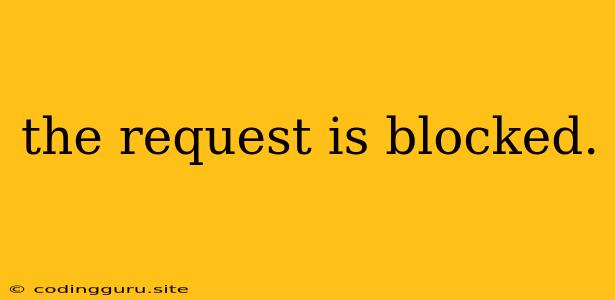Why Is My Request Being Blocked?
In the digital world, we often encounter the frustrating message, "The request is blocked." This cryptic message can appear in various contexts, ranging from web browsing to API calls, and can leave us scratching our heads. Understanding why this happens is crucial for troubleshooting and ensuring smooth online interactions.
Understanding the "Blocked" Message
The message "The request is blocked" signifies that something is preventing your intended action from being executed. This blockage can occur due to various factors, including:
1. Security Measures:
- Firewalls: Your computer, network, or website might have a firewall configured to block certain requests deemed potentially harmful. This could involve blocking requests from specific IP addresses, ports, or websites.
- Anti-Virus Software: Your anti-virus software might be actively blocking requests it perceives as suspicious or malicious.
- Content Filtering: Some networks or websites might use content filtering mechanisms to block access to certain types of content, including inappropriate material or restricted websites.
2. Network Issues:
- DNS Errors: A corrupted DNS cache or DNS server issues can prevent your device from resolving domain names correctly, leading to blocked requests.
- Network Connectivity: Intermittent or poor network connection can result in blocked requests, especially if your internet service provider (ISP) is experiencing outages or throttling.
3. Server-Side Issues:
- Server Overload: The website or service you are trying to access might be experiencing high traffic or server overload, leading to request blocks.
- Server Maintenance: The server hosting the website or service might be undergoing maintenance, causing temporary interruptions and request blocks.
- IP Address Blocking: Your IP address might have been blocked by the server due to suspicious activity, exceeding the request limit, or other reasons.
4. Client-Side Issues:
- Browser Extensions: Certain browser extensions might interfere with your requests, blocking access to websites or specific features.
- Cookies and Cache: Corrupted cookies or browser cache can cause issues with website functionality and block requests.
- Outdated Browser: Using an outdated browser might not be compatible with certain websites, resulting in blocked requests.
Troubleshooting Techniques
Here are some steps you can take to troubleshoot and fix the "The request is blocked" message:
1. Check Your Network Connection:
- Ensure your internet connection is stable and working properly.
- Try restarting your modem and router to reset the connection.
2. Verify Firewall and Anti-Virus Settings:
- Temporarily disable your firewall and anti-virus software to see if the issue persists.
- Check for any blocked websites or applications in your firewall settings and ensure they are not preventing your requests.
3. Clear Your Browser Cache and Cookies:
- Deleting your browser's cache and cookies can resolve issues related to corrupted data.
- Try using a different browser to see if the issue persists.
4. Update Your Browser:
- Ensure you are using the latest version of your browser, as outdated versions can cause compatibility issues.
5. Contact Website Support:
- If the issue persists, try contacting the website or service you are trying to access for assistance.
6. Use a VPN:
- If you suspect your IP address is blocked, using a Virtual Private Network (VPN) can mask your IP and allow you to access the website.
7. Wait It Out:
- If the issue is due to server overload or maintenance, wait for a while and try again later.
Examples of Blocked Requests
Here are some examples of common scenarios where you might encounter the "request is blocked" message:
- Website Access: You try to visit a website, but it displays an error message stating "The request is blocked." This could be due to a firewall, content filtering, or server issues.
- API Call: You are developing an application and attempt to make an API call, but the request is blocked. This could be due to rate limiting, API key issues, or server configuration.
- File Download: You try to download a file from a website, but the request is blocked. This could be due to file size restrictions, security measures, or server overload.
Conclusion
The "request is blocked" message can be a frustrating encounter, but understanding its root cause is crucial for effective troubleshooting. By exploring the potential reasons behind the blockage, from security measures to network issues, you can systematically address the problem and ensure smooth online interactions. Remember to consider both client-side and server-side factors, and utilize available troubleshooting techniques to restore access to the desired content or service.
